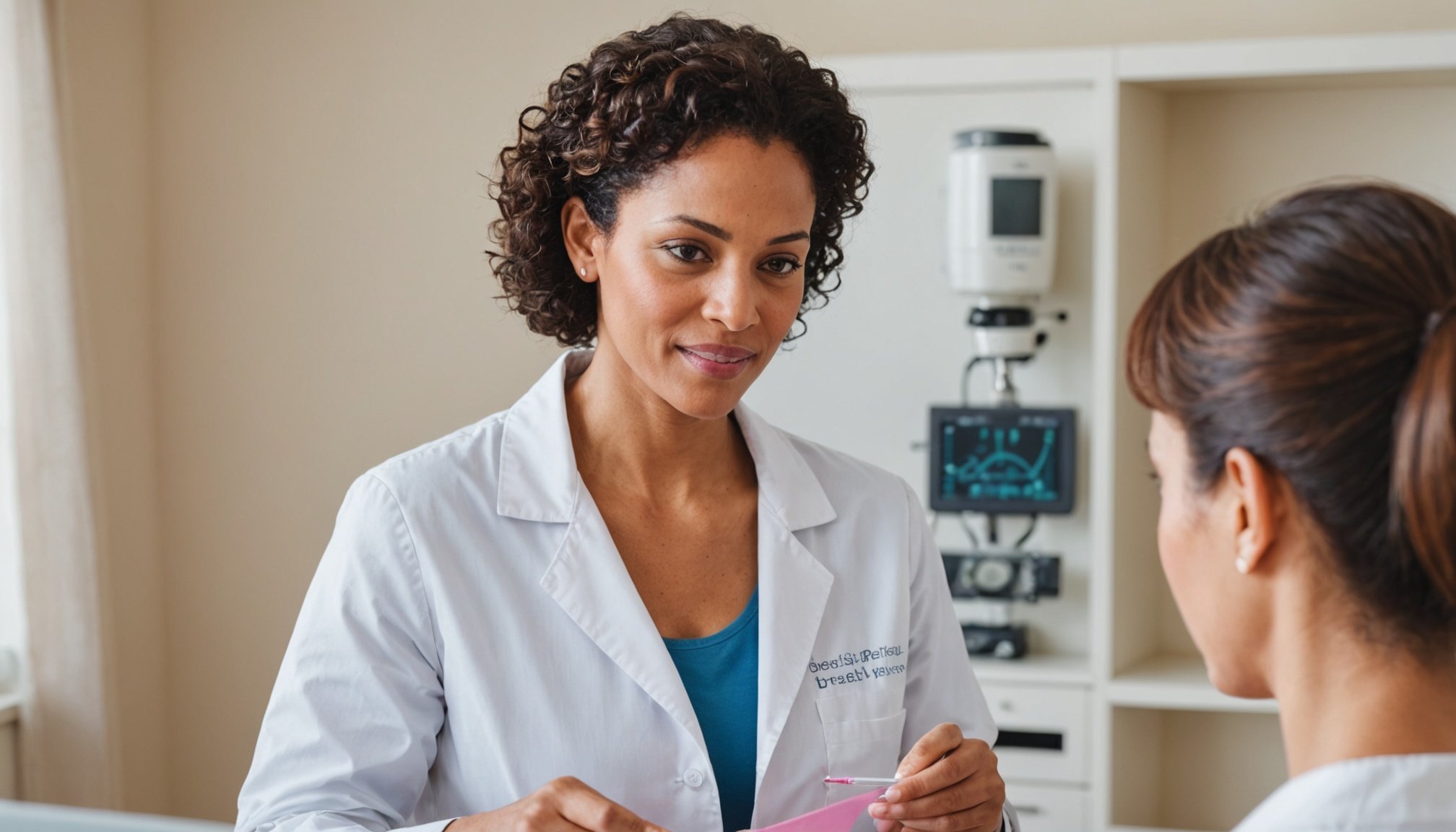Self-breast exams are an empowering tool for maintaining breast health. Understanding how to perform these exams correctly can make a difference in early detection of potential issues. This step-by-step guide will simplify the process, offering clear instructions and important tips to help foster awareness. By integrating self-exams into your routine, you're taking proactive steps towards your health, ensuring peace of mind and personal ownership over your wellness journey. Embrace the confidence that comes with knowledge; your breasts deserve this attention.
Importance of Self-Breast Exams
Understanding the significance of breast health awareness is crucial for every individual. Regular self-breast exams are a vital component of this awareness, providing an opportunity to detect potential issues early.
Topic to read : Essential Strategies for Parents to Successfully Manage Young Children”s Screen Time
Overview of Breast Health and Its Significance
Maintaining good breast health is more than just a personal responsibility; it is an essential aspect of overall well-being. By performing self-exams, individuals can become familiar with the normal state of their breasts, making it easier to notice any changes. This practice empowers people to take charge of their health, promoting proactive measures rather than reactive responses.
Statistics on Breast Cancer Detection Through Self-Exams
Self-breast exams have proven to be a valuable tool in the early detection of breast cancer. According to recent studies, a significant percentage of breast cancer cases are discovered by individuals themselves before any clinical symptoms appear. This proactive approach can lead to earlier diagnosis and, consequently, more effective treatment options. Here is a simple breakdown:
Also to read : Calm your mind: simple breathing exercises for anxiety relief
| Detection Method | Percentage of Cases Detected |
|---|---|
| Self-Breast Exams | 25-30% |
| Clinical Examinations | 40-50% |
| Mammograms | 20-30% |
Emotional and Psychological Benefits of Regular Self-Awareness
Beyond the physical benefits, regular self-breast exams offer emotional and psychological advantages. They foster a sense of control and self-reliance, reducing anxiety about potential health issues. This practice encourages individuals to listen to their bodies and trust their instincts. By incorporating self-exams into their routine, people can feel more connected and attuned to their own health, leading to a more positive and empowered outlook on life.
In conclusion, the importance of self-exams cannot be overstated. By embracing this simple yet powerful practice, individuals can enhance their breast health awareness and take a proactive stance in maintaining their well-being.
How to Perform a Self-Breast Exam
Performing a self-breast exam is an empowering practice that helps individuals take charge of their breast health. Understanding the process ensures accuracy and effectiveness.
Preparation for the Exam
Before beginning a self-breast exam, it is essential to prepare properly. The best time to conduct an exam is a few days after your menstrual cycle ends, when breasts are least likely to be swollen or tender. Ensure you are in a comfortable environment, free from distractions. Gather necessary materials such as a mirror and a comfortable chair or bed. Familiarize yourself with your breast anatomy for a better understanding of what is normal for you.
Step-by-Step Instructions
A self-breast exam involves both visual and physical assessments. Start by standing in front of a mirror with your shoulders straight and arms on your hips. Look for any visible changes in size, shape, or color. Next, raise your arms and look for the same changes. Use a firm, smooth touch with the first few fingers of your hand, keeping the fingers flat and together. Cover the entire breast from top to bottom, side to side—from your collarbone to the top of your abdomen, and from your armpit to your cleavage. Use different pressure levels to feel all breast tissue.
Tips for checking different areas:
- Use light pressure for the skin and tissue just beneath.
- Apply medium pressure for tissue in the middle of your breasts.
- Use firm pressure for deep tissue in the back.
Utilizing Resources
Enhance your self-breast exam technique by utilizing various resources. Illustrations and videos can provide visual guidance, ensuring you perform each step correctly. Consider accessing recommended online resources for further education on breast health. Mobile apps and tools can serve as helpful reminders and tracking aids, allowing you to maintain a consistent exam schedule and record any findings. This proactive approach ensures you stay informed and confident in your self-care routine.
What to Look For During an Exam
Identifying potential breast abnormalities during self-exams is crucial for maintaining breast health. Familiarity with common signs and symptoms can empower individuals to detect issues early.
Common Signs and Symptoms
When performing a self-breast exam, it is essential to be aware of various signs of breast issues. Look for lumps or thickening in the breast or underarm area, as these may indicate abnormalities. Changes in size, shape, or symmetry of the breasts should also be noted. Other symptoms include dimpling or puckering of the skin, redness, or scaliness of the nipple or breast skin, and discharge from the nipples.
Key symptoms to watch for:
- New lumps or mass
- Skin irritation or dimpling
- Nipple pain or retraction
- Redness or scaliness of the nipple or breast skin
Importance of Knowing Your Baseline
Understanding your baseline is critical for effective detection of breast abnormalities. By regularly performing self-exams, you become familiar with the normal look and feel of your breasts. This baseline knowledge allows you to detect subtle changes that might otherwise go unnoticed. Establishing a routine helps in identifying any new or unusual developments, making it easier to recognize potential signs of breast issues early on.
When to Be Concerned and Seek Medical Advice
While some variations in breast tissue are normal, certain changes warrant medical attention. If you notice persistent lumps, significant changes in breast shape or size, or any of the aforementioned symptoms, it is advisable to consult a healthcare professional. Early intervention is key, and seeking medical advice can provide peace of mind and ensure timely treatment if necessary. Prioritizing your health by addressing concerns promptly is a proactive approach to managing your breast health.
Building a Routine for Breast Health
Establishing a consistent routine is essential for maintaining optimal breast health.
Establishing a Monthly Self-Exam Schedule
Creating a breast health routine begins with a commitment to regular self-exams. By scheduling these exams monthly, individuals can ensure they remain vigilant about their breast health. A practical approach is to select a specific date each month, ideally a few days post-menstruation, when breasts are less likely to be tender. This consistent practice not only fosters familiarity with one's baseline but also aids in the early detection of any abnormalities.
Tips for a successful self-exam routine:
- Choose a date easy to remember.
- Use reminders or calendar alerts.
- Record observations in a dedicated journal.
Incorporating Professional Check-Ups into Your Routine
In addition to self-exams, integrating professional check-ups is a crucial component of a comprehensive breast health routine. Regular visits to a healthcare provider for clinical breast exams and mammograms, as recommended, can enhance early detection efforts. These professional assessments provide expert insights and reassurance, complementing the individual's self-examination efforts.
Key professional check-up considerations:
- Follow age-specific guidelines for mammograms.
- Discuss any changes or concerns with your healthcare provider.
- Consider genetic counseling if there's a family history of breast cancer.
Staying Informed About Breast Health Advancements and Research
Being well-informed about the latest breast health advancements and research is vital for a proactive approach. Keeping abreast of new findings, technologies, and recommendations can empower individuals to make informed decisions about their health. Subscribing to trusted medical journals or newsletters, attending health seminars, and engaging in community discussions are excellent ways to stay updated.
Benefits of staying informed:
- Access to the latest screening technologies.
- Awareness of new treatment options.
- Understanding of emerging risk factors and preventive measures.
By weaving these elements into a breast health routine, individuals can take charge of their well-being with confidence and assurance.
Resources for Further Learning
Delving deeper into breast health is crucial for empowerment and informed decision-making.
Recommended Books and Articles
Exploring breast health resources is an excellent way to gain comprehensive knowledge. Several books and articles offer in-depth information on maintaining breast health and understanding the nuances of breast cancer. Works by renowned authors in the field provide valuable insights into prevention, early detection, and treatment options. These educational materials serve as a foundation for those seeking to enhance their understanding of breast health.
Notable recommendations:
- "The Breast Cancer Survival Manual" by John Link
- "Dr. Susan Love's Breast Book" by Susan M. Love
- Articles in the Journal of Clinical Oncology
Support Groups and Organizations
Engaging with support groups and organizations dedicated to breast health can be immensely beneficial. These entities offer emotional support, share experiences, and provide educational materials to help individuals navigate their breast health journey. Being part of a community fosters a sense of belonging and reassurance, empowering individuals to face challenges with confidence.
Key organizations:
- National Breast Cancer Foundation
- Susan G. Komen
- Breast Cancer Research Foundation
Online Platforms for Community Support
Online platforms are invaluable breast health resources for community support and sharing experiences. These digital spaces allow individuals to connect, discuss, and learn from one another. Access to forums, webinars, and virtual support groups offers a flexible way to stay informed and engaged, making it easier to incorporate breast health practices into everyday life.
Popular platforms:
- BreastCancer.org
- Health Unlocked's Breast Cancer Community
- Inspire's Breast Cancer Support Group
By leveraging these educational materials and community resources, individuals can enhance their knowledge and support network, fostering a proactive approach to breast health.











